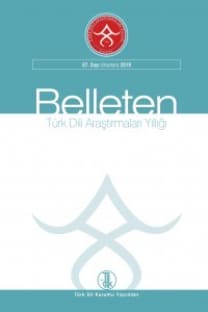Türk Taş Heykelleri ve Moğol Taş Heykelleri
Eski Türklerden kalma taş heykeller esas olarak iki grupta ele alınabilir: Sağ elinde bir kadeh tutanlar, her iki elinde kadeh tutanlar. İlk grup esasen Türk kağanlıkları dönemine aittir. İkinci grup ise 8-9. yüzyıllarda görülmeye başlanıp 13. yüzyıla kadar devam ederler. Birinci grup esas olarak erkeklere aittir ve genelde de kağanların kabirleri çevresindedir. İkinci grup kadınlara ait heykelleri de içerir. İlk grup taş heykel geleneği Uygur Kağanlığı dönemiyle sona ermiş görünmektedir. İkinci grup kuzeybatı Moğolistan’dan başlar Kazakistan’a, Güney Rusya’ya (Kıpçak Bozkırı) değin uzanır. Özellikle Moğol dönemiyle birlikte taş heykellerde, Kıpçaklardan kalma heykellerde Moğol ve Çin etkisi de görülür
Anahtar Kelimeler:
Balbal, taş heykeller, Türk Kağanlığı, Uygur Kağanlığı, Kıpçaklar
CHANGE FROM TURKIC STONE STATUES TO MONGOLIAN STONE STATUES
The stone statues remaining from the Old-Turkic people can basically be divided into two groups: The statues holding a bowl in their right hands and the statues holding two bowls in both hands. The first group principally belongs to the Turkic Khanate era. The statutes in the second group belong to a period from the 8th and 9th centuries to the 13th century. The statues of the first group are mainly the statues of males and they are located in the area near the tombs of the Khans. The second group includes also the female statues. The tradition of stone sculpture of the first group seems to be ended by the Uygur Khanate period, whereas sculpture activity of the second group can be seen for a longer period and in a wider area from Mongolia to Kazakhstan and southern Russia (Kipchak Steppe). With the Mongol period, the Mongolian and Chinese influences can be seen in the stone statues remaining from the Kipchaks
Keywords:
balbals, stone status, Turkic Qaghanate, Uighur Qaghanate, Kipchaks,
- ISSN: 0564-5050
- Başlangıç: 1953
- Yayıncı: Türk Dil Kurumu
